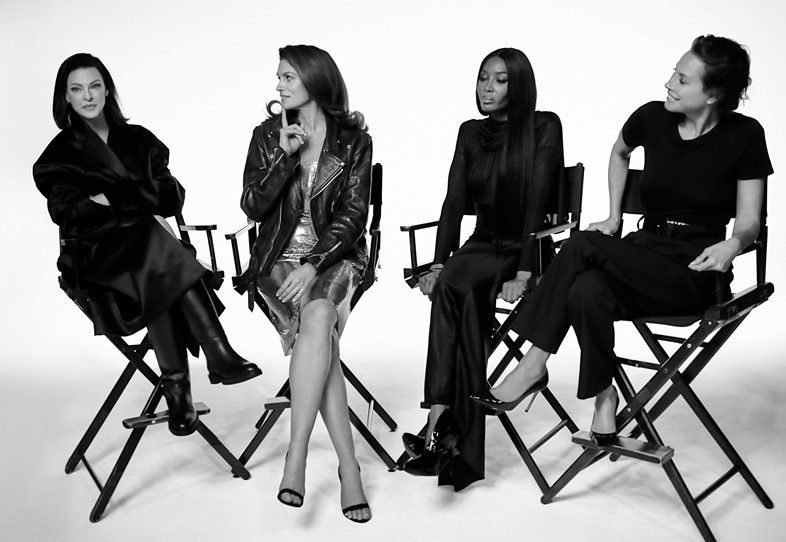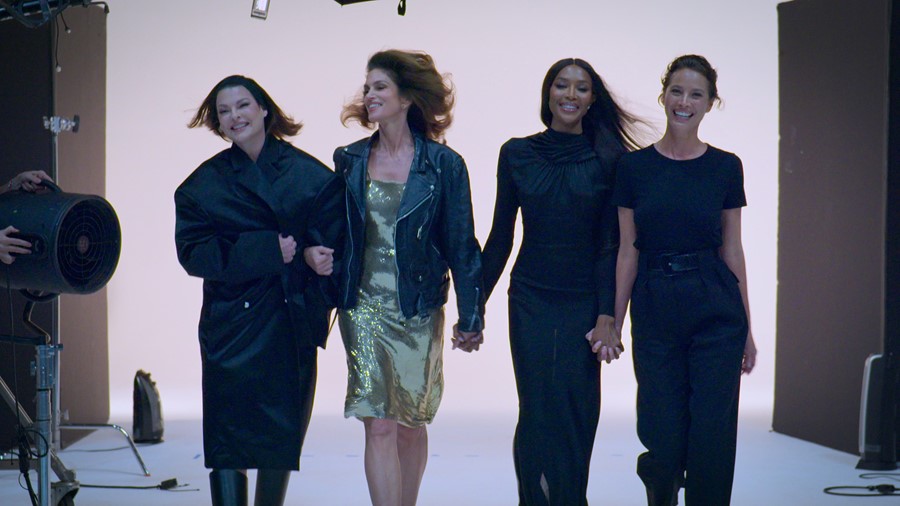A new documentary from Apple TV+ shows how a group of young women – Naomi Campbell, Cindy Crawford, Linda Evangelista and Christy Turlington – captured the cultural zeitgeist and scaled the heights of a male-dominated industry
As we get ever further from the 90s, the term ‘supermodel’ only becomes more nostalgic and evocative. It’s a throwback to a time when a coterie of young women – from different countries and backgrounds, though all incredibly photogenic – captured the cultural zeitgeist by turning their glamorous but gruelling profession into the height of aspiration. “They were the original influencers,” says Larissa Bills, co-director of The Super Models, a riveting new documentary series about four icons of the era: Naomi Campbell, Cindy Crawford, Linda Evangelista and Christy Turlington. “They transcended the fashion and became the personalities of the fashion more than the fashion itself. They were the avatars of that culture.” Bills’ co-director Roger Ross Williams notes drily that we will probably never see their like again because “in the age of Instagram, everyone’s a supermodel now”.
Campbell, Crawford, Evangelista and Turlington serve as executive producers on the series, which shines a spotlight on their agency and legacy as well as their era-defining photo shoots. “We looked powerful, and then we acted powerful, and then we became powerful,” Crawford tells us, neatly summarising the meteoric rise of the ‘supers’ in the late 80s and early 90s. “What I really took away from making this series is that beauty and feminism are not mutually exclusive,” says Bills. “These women were part of a movement, along with Madonna, that said women could be sexy and wear high heels and lipstick, and yet still be powerful. If these women were good at selling beautiful clothes and making beautiful images, what’s wrong with that?” Bills acknowledges there is a “complexity” in viewing the supers as right-on role models, but also says, fairly, that “there’s more than one way to be a feminist”.
When the series’ four subjects posed for the cover of British Vogue in January 1990 – joined by a fifth supermodel, Tatjana Patitz, who sadly passed away earlier this year – they epitomised the modern concept of ‘squad goals’. The Super Models shows us, touchingly, that this sense of solidarity was more than a marketing ploy. In the series, Campbell speaks plainly about the appalling racism she experienced even after she became a household name, and Evangelista recalls telling industry gatekeepers: “If you don’t book her, you don’t get me.” Williams says the four women were “best friends and [chosen] family who did it all together and knew the power they had as a group”.
Though The Super Models is more of a celebration than an exposé, it doesn’t gloss over the misogyny and abuse that these women faced as they navigated a male-dominated industry long before the #MeToo movement. Turlington recalls being asked to pose topless when she was just 17, while Campbell shares a grim encounter with an art director who complimented her breasts, then “felt the need to have to touch them”. After a firm rebuke from late designer Azzedine Alaïa, whom Campbell refers to as “papa”, the unnamed art director “never came near me again”, she says. The series’ revisionary spirit also comes to the fore when Crawford looks back at her 1986 appearance on The Oprah Winfrey Show, when she was joined by modelling agent John Casablancas. Crawford says she felt like a “chattel” when Winfrey asked Casablancas: “Did she always have this body? This is unbelievable,” before turning to her and saying: “Stand up just a moment, now this is what I call a body.” It’s a moment of blatant objectification that, thankfully, would never happen today.

Meanwhile, Evangelista speaks with careful candour about her ex-husband Gérard Marie, the former president of Elite Model Management’s European division, who has been accused of multiple counts of sexual assault and rape in the 80s and 90s. Marie has always denied these allegations, and an investigation into him was closed earlier this year because the alleged crimes occurred too long ago to be prosecuted under French law. “I learned that maybe I was in the wrong relationship,” Evangelista says of her six-year marriage to Marie, which ended in 1993. “It’s easier said than done to leave an abusive relationship. I understand that concept, because I lived it.” She then adds, pointedly: “He knew not to touch my face, not to touch the money-maker, you know?“
Ultimately, The Super Models feels important because it allows its four subjects to tell their stories on their own terms. Because the images they created in the early 90s are so iconic, Bills says the series sometimes feels “like hearing the Mona Lisa speak”. Williams points out that, despite their individual highs and lows, not all of which are fully covered, these four women “are still working and garnering attention” more than 30 years later. In an industry that fetishises youth as well as beauty, that is definitely an achievement worth celebrating. “Imagine trying to coincide schedules with these four iconic women,” he adds with a laugh. “We’re documentary-makers, so we move slow. But fashion moves fast, so they move fast too. And honestly, we have never experienced glam on this level before. These women are so professional and know exactly what it takes to make a great picture.” For this reason, it’s heartening – as well as fascinating – to see them get their full dues.
The Super Models is streaming now on Apple TV+.
